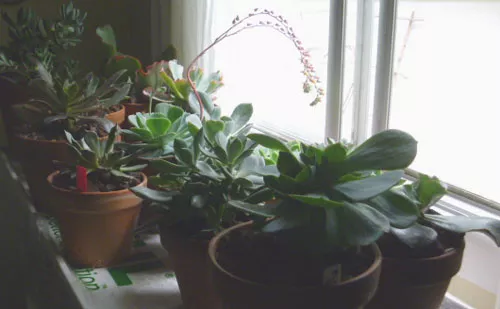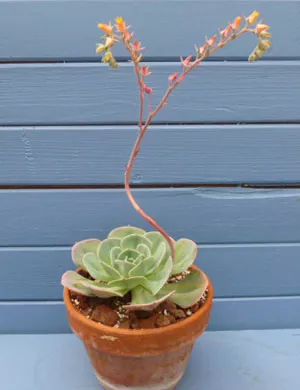As an Amazon Associate I earn from qualifying purchases.
Other links on this site may lead to other companies that I’m associated with.
The Most Beautiful and Intriguing Succulents
Echeveria species found in the wild almost two centuries ago have been grown as houseplants on bright windowsills and in the greenhouses of collectors for many generations.

An Echeveria species collection in a bright window
The Discovery and Naming of Echeveria
Echeveria were named after Mexican botanical artist Atanasio Echeverría y Godoy in 1828 by the French botanist Augustin Pyramus de Candolle (DeCandolle) who was very impressed with Echeverría’s drawings.
Echeverría went on the the Sessé and Mociño expedition (led by Martin de Sessé y Lacasta and Mariano Mociño Suárez de Figueroa) to explore Mexico and northern Central America and produced thousands of botanical illustrations.
New species are still being discovered in modern times, one of the latest called Echeveria kimnachii in Mexico and another named Echeveria cante.
The Geographical Origin of Echeveria species
The genus Echeveria is a member of the large Crassula family (Crassulaceae), which has about 1,400 species in 33 genera with worldwide distribution.
Did You Know?
Other members of the Crassulacean family to which Echeveria belongs include Crassula, Sedum, Graptopetalum, Pachyphytum and several other genera, some of which are so closely related they can hybridize to form x Graptoveria, x Sedeveria and x Pachyveria.
The Echeveria genus, with approximately 180 species, is native to mid to higher elevations in the Americas with the main distribution in Mexico and Central America.
One species is found from as far north as southern Texas and several species occur as far south as Bolivia, Peru and possibly Argentina.
They are discovered only by intrepid explorers, as they tend to grow in inhospitable places such as cliffs and very hot areas.
Cross pollinating the Echeveria species creates new Echeveria hybrids, some of which are sterile so can’t be used for further breeding, others forming the basis of many new forms.
Luckily, the species of Echeveria that are commonly found in collections are amenable to hybridizing, even though they are beautiful in their own right. They are pretty spectacular all the time, but they excel once they start to bloom, with tall arching sprays of bell shaped dangly flowers.
In some cases, species can differ depending on the area they originated,
making a variety or sub species.
There are new discoveries of previously

unknown species even now, making this an exciting journey of discovery.
Some of the Echeveria species commonly found in collections are Echeveria runyonii, of which there are several beautiful hybrids, Echeveria pulidonis, Echeveria racemosa atropurpurea ‘Brown Sugar’, Echeveria glauca, Echeveria imbricata (which is thought to be a hybrid itself – one of the very first, a cross by a French plant collector in 1830), Echeveria macrophylla and many others.
How can you tell which Echeveria are species, and which are hybrids? In the naming of plants the species is always denoted by lower case letters, and hybrids named after a person or with a descriptive name in quotes and capitalized.

